Biography of Hayman Rooke 1723-1806
Hayman Rooke 1723-1806 is in Antiquaries.
On 20 Feb 1723 Hayman Rooke was born. He was baptised at St Martin in the Fields [Map] on 19 Mar 1723.
Archaeologia Volume 6 Section XIII. An account of some Druidical Remains on Stanton and Hartle Moor in the Peak, Derbyshire. By Hayman Rooke (age 57), Esq. Read April 6, 1780.
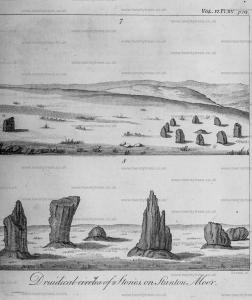
Archaeologia Volume 7 Section XX. Sir,
I am very glad to find that the ingenious major Rooke (age 61) has furnished the Society with drawings of that curious remain of very early fortification, the Caers-work [Map] (or, as the name was given me, the Carles-work) near Hathersage in Derbyshire. It was fisft noticed in print (I believe) in the tour into that country which I ventured to lay before the public this year, but is much better illustrated by the major. If it will not be improper to offer the Society two drawings in addition to those which Mr. Rooke (age 61) has sent, I will beg you to present them.
The number of curiosities of the highest antiquity which that county affords, well deserves attention, and (I speak experimentally) the traveller who shall go in search of them will no where find a greater variety of scenery, than is there presented in succession to his eye. The antiquary will, however, have to lament that while turnpike roads facilitate his visit, the barbarity of turnpike surveyors will destroy the objects of his search; barrows, druidical temples, rocking stones, and whatever comes in their way, fall a prey to their sacrilegious hands. It has been the case with one rocking stone near this Work, which was too near the road to escape; — nimium vicina Cremona! [Note. A quote from Virgil's Eclogues "Cremona is too close"]
Adjoining to Hathersage church yard is a small circular fortification; perhaps that of the enemy which might cause the rude one on the Moor. I am, &c.
William Bray.
Archaeologia Volume 8 Section III. 02 Nov 1785. Observations by the Rev. Mr. Pegge (age 80) on the Stanton-Moor Urns, and Druidical Temple [Map]. In a Letter to Major Rooke (age 62). Read November 2,. 1785;
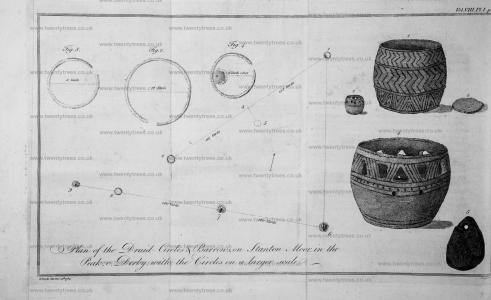
Archaeologia Volume 7 Section XIX. A further account of some Druidical Remains [Carl Wark [Map]] in Derbyshire. By Hayman Rooke (age 62), Esq. Read December 11th, 1785.
Archaeologia Volume 9 Section XVII. Sir, Whittington, March x5, 1788.
John Webster, a farmer at Smiril in the county of Derby, occupies some land belonging to Lord Viscount Howe, which gives him a privilege on Middleton-moor, and wanting this year to burn some lime, he dug for that purpuse into a Tumulus or Low , on that part of the Moor called Garret-piece, and began his work at the bottom of it, on a level with the circumjacent ground.
The Low is about half a mile South-east of the Arbelows [Map], or Arbourlows [Map], of which you have some account in the VIIth volume of Archaeologia [a] ; and when the farmer had proceeded in digging to the center of it, and diredtly under the depression at the top (the Lows generally having a cavity or hollow on their summits he found the three pieces of brass, of which a drawing made by the accurate hand of our worthy and very useful member, Hayman Rooke (age 64), Esq. accompanies this short memoir [b]. The remains of the body there interred, or rather covered with the Low, (for it was laid on the natural ground) were but few, lying East and West, and the round jewel, No. 3, was found placed near the point of the shoulder.
Note a. Mr. Maty observes, whoever goes to Derby must needs know the Lows .... very well? Review, Nov. 1785, p. 351, but now the Lows are not near Derby. However, in p. 131, of Archaeologia, for long; read laeg; and p. 140, for Arax, r. Arwr these being two very material errors.
Note b. See pl. IX.
Archaeologia Volume 12 Section I. Antiquities discovered in Derbyshire. In a Letter from Hayman Rooke (age 70), Esq. F. S. A. to the Rev. Dr. Pegge (age 89), F. S. A. Read November 21, 1793.
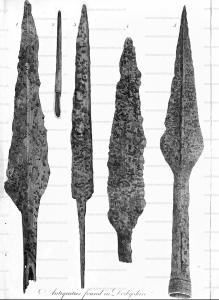
Archaeologia Volume 12 Section XXV. Discoveries in a Barrow [Fin Cop Barrow [Map]] in Derbyshire. In a Letter from Hayman Rooke (age 72), Esq. to Mr, Gough, Read February 11, 1796.
On 18 Sep 1806 Hayman Rooke (age 83) died. He was buried in the chancel of the Church of St Edmund, Mansfield Woodhouse.
Section I Tumuli 1821. In February 1821, the Kenslow farm [Map], near Middleton-by-Yolgrave [Map], being planted and otherwise improved, a barrow [Map] was discovered upon the most elevated part of the land. In the nomenclature of Sir R. C. Hoare (age 62), it was a bowl barrow, composed of earth and stones, of about thirty feet in diameter, and its perpendicular height not more than three feet, with the usual shallow cavity on the top, five feet in diameter. The examination was commenced by a transverse section from the south side towards the middle of the tumulus. On approaching about six feet towards the centre a few human bones were discovered, promiscuously blended with those of a small animal, which Dr. Buckland has decided to be of the water rat (Reliquia Diluviana, plate ii, figs. 1, 2, 3, and 12), intermixed with a fine dry sand or mouldy slightly indicating calcination among which was a piece of ivory or bone the one side of which is convex the other flat with two perforations equidistant from the points which probably allowed of its being worn as a pensile ornament from the neck. In the centre of the barrow the rats' bones appeared in large quantities and in digging a little below the level of the natural ground the discovery of the primary deposit was made consisting of two skeletons one entire and the other nearly so laid at full length, about eighteen inches below the surface, in a cist or excavation of the soil, guarded nearly round, but particularly on the south and east sides, by large stones. The bodies had been deposited side by side, with their heads to the north-west; each head was placed in the hollow of a mass of magnesian lime-stone (of which the hill is composed), and reclining on the right side. Neither of them could be conveniently measured, but a thigh-bone was exactly eighteen inches in length, which, in a well-proportioned man, gives a height of about five feet ten inches. It is remarkable that not a tooth was wanting, or in the least decayed, in the jaws of either; and though, in one more particularly, the molars were much worn, as if by the mastication of hard substances, the enamel was still retained. The bones generally were but little decayed. One of the skulls appears to have been that of a man in the decline of life, and exhibits phrenological developments indicative of some of the worst passions incident to human nature. The other skull was crushed on removing the stone on which it lay. Near the bodies, and especially about the heads, a large quantity of the rats' bones and fine mould were strewed, with many round pebbles of various sizes, chiefly of quartz, which, in the opinion of Sir R. C. Hoare (age 62), were used in the sling. On the breast of the entire skeleton lay a circular fibula, or brooch, of copper or bronze. There was also a large quartz pebble and a fragment of pottery of red clay. Between the bodies was placed an axe- or hammer-head of basalt, in a decomposed state, and broken in the middle. In the same situation was found a porphyry slate pebble, highly polished, of very singular shape, four and a half inches in length, the same in medium circumference, the sides triangular and tapering towards the ends, which are rubbed flat. In vol, xii, p. 327, of the "Archæologia" a similar stone is described and engraved which was found in a barrow near Ashford-in-the-Water [Map] by Major Rooke. Behind the head lay a tusk apparently that of a dog and a molar tooth of the lower jaw of a horse. On these little if any decay seemed to have taken place.
Thomas Bateman 1824. June 1st, 1824, an ineffectual attempt was made to open the immense tumulus [Map] forming part of the temple of Arbor Lowe [Map]. A deeper cutting was made in the same direction as the one made by Major Rooke in 1782, which was equally abortive; the only articles found by the Major being the almost universal rats' bones and part of a stag's horn; on the later attempt nothing occurred but one human tooth and some animal bones.
Stephen Glover 1831. Between two and three miles north—east of Newhaven, at a little distance beyond the Roman road from Buxton to Little Chester, is one of the most remarkable monuments of antiquity in Derbyshire. This is the Arbor-Low or Arbelows [Map], a druidical circle, surrounded by a ditch and vallum. Its situation, though considerably elevated, is not high as some eminences in the neighbouring country ; yet it commands an extensive view, especially to the north-east. The area, encompassed by the ditch, is about fifty yards in diameter, and of a circularfurm ; though, from a little declination of the ground towards the north, it appears somewhat elliptical, when viewed from particular points. The stones which compose the circle are rough and unhewn masses of limestone, apparently thirty in number; but this cannot be determined with certainty, as several are broken. Most of them are from six to eight feet in length, and three or four broad in the widest part; their thickness is more variable, and their respective shapes are different. They all lie on the ground, and generally in an oblique position; but the opinion that has prevailed, of the narrowest end of each being pointed towards the centre, in order to represent the rays of the sun, and prove that luminary to have been the object of worship, must have arisen from inaccurate observation: for they almost as frequently point towards the ditch as otherwise. Whether they ever stood upright, as most of the stones of druidical circles do, is an enquiry not to determine; though Mr. Pilkington was informed, that a very old man living in Middleton, remembered, when a boy, to have seen them standing obliquely upon one end. This secondary kind of evidence does not seem entitled to much credit as the view of the stones themselves and their relative situations are almost demonstrative of the contrary. Within the circle are some smaller stones scattered irregularly and near the centre are three larger ones erroneously supposed to have once formed a cromlech The width of the ditch which immediately surrounds the area on which the stones are placed is about six yards the height of the bank or vallum on the inside is from six to eight yards but this varies throughout the whole circumference which on the top is nearly two hundred and seventy yards. The vallum seems to have been formed of the earth thrown up from the ditch. To the enclosed area are two entrances each of the width of ten or twelve yards and opening on the north and south. On the east side of the southern entrance is a large barrow standing in the same line of circumference as the vallum but wholly detached excepting at the bottom. This barrow was opened in June 1782 by H Rooke esq and the horns of a stag were discovered in it and June 1 1824 by Mr Samuel Mitchell (age 27) of Sheffield and the engraving here inserted is copied from an accurate drawing made by that gentleman.
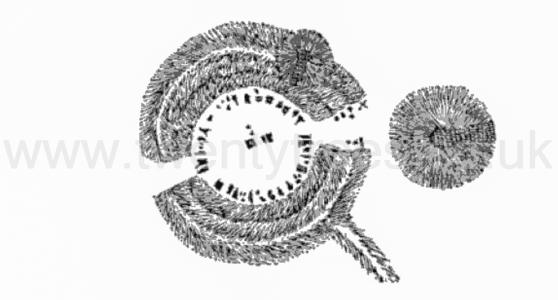
Thomas Bateman 1845. The 23d of May, 1845, is an important day in the annals of barrow-digging in Derbyshire, as on that day was made the discovery, so long a desideratum, of the original interment in the large tumulus [Map], which forms one side of the southern entrance to the temple of Arbor Lowe [Map], and which had been unsuccessfully attempted on previous occasions by three parties of antiquaries: first, about 1770, by the occupier of the land whereon the temple is situated; secondly, in 1783, by the celebrated archaeologist. Major Rooke (see p. 31, 1st Jun 1824), who laboured with no effect for three days; and thirdly, on the 1st and 2d of June, 1824, by Mr. Samuel Mitchell (age 42) and Mr. William Bateman, who succeeded no better (see p. 31). But, to return to the narrative. Operations were commenced on the day before mentioned, by cutting across the barrow from the south side towards the centre. A shoulder-blade and an antler of the large red deer were found in this excavation, which also produced an average quantity of rats' bones. On reaching the highest part of the tumulus, which owing to the soil and stones removed in the former excavations, is not in the centre, but more to the south, and is elevated about four yards above the natural soil, a large, flat stone was discovered, about five feet in length by three feet in width, lying in a horizontal position, about eighteen inches higher than the natural floor. This stone being cleared and carefully removed, exposed to view a small six-sided cist, constructed by ten limestones, placed on one end, and having a floor of three similar stones, neatly jointed. It was quite free from soil, the cover having most effectually protected the contents, which were a quantity of calcined human bones, strewed about the floor of the cist, all which were carefully picked up, and amongst them were found a rude kidney-shaped instrument of flint, a pin made from the leg-bone of a small deer, and a piece of spherical iron pyrites.
At the west end of the cist were two urns of coarse clay, each of which was ornamented in a peculiar and widely dissimilar manner. The larger one had fallen to pieces from the effects of time and damp, but has since been restored, and is a very elegant vase; the smaller was taken out quite perfect, and is of much ruder design and workmanship. In addition to these urns, one piece of the ornamented upper edge of another, quite distinct from either of them, was found. The floor of the cist was laid upon the natural soil and the cist was strewed with rats' bones, both within and without.
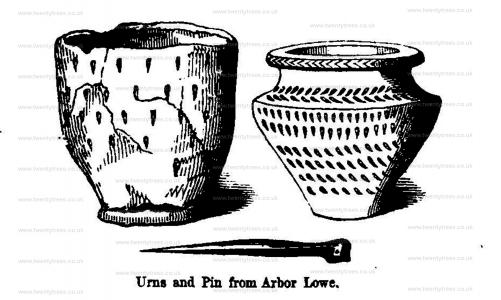
John Lubbock 1879. The celebrated Temple of Arbor Low, the most important monument of the kind in this part of England, consists of a circle of large, unhewn limestones surrounded by a deep ditch, outside of which rises a lofty vallum. The stones composing the circle are rough, unhewn masses, about thirty or forty in number; though as several are broken, this cannot exactly be determined; they are from six to eight feet in length, by about three or four feet in breadth at the widest part. At present they are all lying on the ground, and it is doubtful whether they were ever upright. Within the circle are some smaller scattered stones, and in the centre are three larger ones, which may, perhaps, have originally formed a dolmen, or sepulchral chamber. The central platform is 167 feet in diameter. The width of the fosse is about 18 feet; the height of the bank or vallum on the inside (though much reduced by the unsparing hand of Time), is still from 18 to 24 feet. The vallum is chiefly formed of the earth thrown out of the ditch, with a little from the ground which immediately surrounds the exterior of the vallum; thus adding to its height, and to the imposing appearance it presents to any one approaching from a distance. To the enclosed area are two entrances, each of the width of ten or twelve yards, and opening towards the north and south. On the east side of the southern entrance is a large barrow [Map], holding, in the opinion of some archaeologists, the same relation to the circle as Long Meg [Map] to the circle of stones [Map] near Penrith, known as her "daughters." This mound was first attacked in 1770, by the then occupier of the farm; secondly, in 1782, by Major Rooke; and thirdly, in 1824, by Mr. William Bateman; but none of these gentlemen succeeded in discovering the interment. At length, in 1845, Mr. Thomas Bateman was more fortunate.